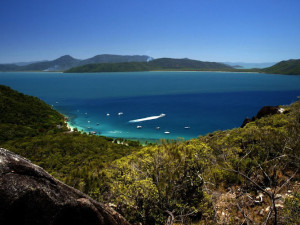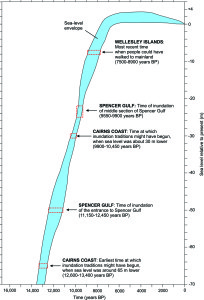
Aboriginal stories say Fitzroy Island on the Great Barrier Reef was connected to the mainland. It was, at least 10,000 years ago. Felix Dziekan
So goes an Aboriginal story, paraphrased, about the origin of the Wellesley Islands in the southern Gulf of Carpentaria, a story with parallels along every part of the coast of Australia. Along the south coast, stories written down early in colonial times told when these areas were dry, a time when people hunted kangaroo and emu there, before the water rose and flooded them, never again to recede.
In a recent paper we presented at an indigenous language conference in Japan, we analysed 18 stories from around Australia’s coast. All tell tales of coastal flooding. We argue that these stories (and probably many others) recall coastal inundation as sea levels reached their present level at least 6,000-7,000 years ago.
The end of the ice ages
Around Australia, we know that at the coldest time of the last ice age about 20,000 years ago, sea level stood about 120 meters below its present level.
When the last ice age began to end, a few thousand years later, huge masses of ice that had built up on the land, particularly in the northern hemisphere, began melting. Water poured into the world’s oceans, raising their levels in ways that are now well understood.
By about 13,000 years ago, sea level had risen to around 70 meters below its present level. One thousand years later, it had risen to about 50 meters below present.
These dates give us a ballpark for how old stories of flooding may be. Could they have reached us from 13,000 years ago?
Tracing tales
Several decades ago, linguists working with Aboriginal groups along the Queensland coastal margin recorded stories about a time when the ancestors of these people lived at the coast “where the Great Barrier Reef now stands”.
One version of the story collected from the Yidindji people of the Cairns area recalls a time when Fitzroy Island was part of the mainland and offshore Green Island was four times larger. The story describes several named landmarks with remembered historical-cultural associations that are now underwater.
We can be almost certain that the people of this area did occupy the coast “where the Great Barrier Reef now stands” during the last ice age for it would have comprised broad floodplains and undulating hills with a range of subsistence possibilities, bordered in most parts by steep cliffs plunging down to the narrow shore.
The question is whether the details in these stories recall this time for, if they do, then the story might date from as much as 13,000 years ago. A more conservative interpretation, based on a sea level just 30 meters lower than today, would place the age of this story at around 10,000 years ago.
Similar stories come from Spencer Gulf in southern Australia. Those from the Narrangga people of Yorke Peninsula recall the time when there was no Spencer Gulf, only “marshy country reaching into the interior” lying just above the ocean surface and dotted with “freshwater lagoons” where birds and other animals flocked.
One day the sea came in, perhaps through the breaching of a natural barrier, and the area has since been submerged. If these stories refer to flooding across the outermost lip of Spencer Gulf, which today lies around 50 meters below present sea level, then they may have originated 12,000 years ago. Even if they refer to inundation of the central part of the Gulf, they are likely to be more than 9,000 years old.
Ancient stories
How sea levels changed after the ice ages around Australia is now well known. So if these stories are accepted as authentic and based on observations of coastal flooding, it is clear that they must be of extraordinary antiquity.

The historical record shows when parts of the Australian coast flooded. Nick Reid & Patrick Nunn, Author provided
How do we know that these stories are authentic? We suggest that because they all say essentially the same thing, it is more likely that they are based on observation. All tell of the ocean rising over areas that had previously been dry. None tell stories running the other way – of seas falling to expose land.
The huge distances separating the places from which the stories were collected – as well as their unique, local contexts – makes it unlikely that they derived from a common source that was invented.
For such reasons, we regard the common element in these stories about sea level inundating coastal lowlands, sometimes creating islands, as based on observations of such an event and preserved through oral traditions.
Is Australia unique?
The rise of sea level since the last ice age from 120 meters below present occurred not just around Australia but around the world, inundating significant parts of all continents.
We might expect to find comparable collections of sea-level rise stories from all parts of the globe, but we do not. Perhaps they exist, but have been dismissed on account of an improbable antiquity by scholars adhering to the more orthodox view that oral traditions rarely survive more than a millennium.
Another possibility is that Australia is genuinely unique in having such a canon of stories. That invites questions about why and how Australian Aboriginal cultures may have achieved transmission of information about real events from such deep time.
The isolation of Australia is likely to be part of the answer. But it could also be due to the practice and nature of contemporary Aboriginal storytelling. This is characterized by a conservative and explicit approach to “the law”, value given to preserving information, and kin-based systems for tracking knowledge accuracy.
This could have built the inter-generational scaffolding needed to transmit stories over vast periods, possibly making these stories unique in the world.
This conclusion in turn raises many interesting questions.
By Nick Reid & Patrick Nunn
Reprinted from The Conversation read the original story:
http://theconversation.com/ancient-aboriginal-stories-preserve-history-of-a-rise-in-sea-level-36010




